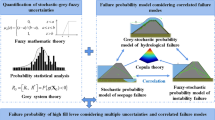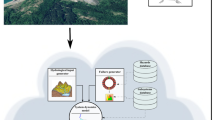Abstract
This study presents an innovative stochastic approach based on the failure modes and effects analysis to evaluate the failure risk of Amir Kabir dam in Iran. To compute the risk priority number, several risk factors including, occurrence probability, severity, and detectability are quantified using expert opinions. In this way, the participant experts are divided into four groups including; dam operation staff, water company staff, academic staff and, other experts. Moreover, the weights of the expert groups are also considered to compute the risk priority number. Hence, a new failure modes and effects analysis called modified stochastic failure modes and effects analysis is provided by considering weights of expert groups and risk factors. Furthermore, Monte Carlo simulation is used to consider the weights uncertainty and compute a stochastic-based risk priority number. Results show that the first priority failure modes of the upstream and downstream basins of Amir Kabir dam are the human-based failure modes while a nature-based failure mode is observed with most priority in dam body. In general, the proposed stochastic failure risk method provides reliable results with low uncertainty to evaluate the failure modes through a risk assessment process.









Similar content being viewed by others
References
Bevilacqua M, Braglia M, Gabbrielli R (2000) Monte Carlo simulation approach for a modified. Qual Reliab Eng Int 16:313–324
Bowles JB, Peláez CE (1995) Fuzzy logic prioritization of failures in a system failure mode, effects and criticality analysis. Reliab Eng Syst Saf 50:203–213. https://doi.org/10.1016/0951-8320(95)00068-D
Braglia M (2000) MAFMA: multi-attribute failure mode analysis. Int J Qual Reliab Manag 17:1017–1033. https://doi.org/10.1108/02656710010353885
Catelani M, Ciani L, Venzi M (2018) Failure modes, mechanisms and effect analysis on temperature redundant sensor stage. Reliab Eng Syst Saf 180:425–433
Chin KS, Wang YM, Ka Kwai Poon G, Yang JB (2009) Failure mode and effects analysis using a group-based evidential reasoning approach. Comput Oper Res 36:1768–1779. https://doi.org/10.1016/j.cor.2008.05.002
da Silva Monte MB, Morais DC (2019) A decision model for identifying and solving problems in an urban water supply system. Water Resour Manag:1–14
Gabriel-martin I, Sordo-ward A, Garrote L, Castillo L. G (2017) Influence of initial reservoir level and gate failure in dam safety analysis Stochastic approach. J Hydrol 550:669–684. doi: https://doi.org/10.1016/j.jhydrol.2017.05.032
Ghosh S. N (1997) Flood control and drainage engineering. CRC Press
Hadi-Vencheh A, Aghajani M (2013) Failure mode and effects analysis: a fuzzy group MCDM approach. J Soft Comput Appl 2013:1–14
Ho CC, Chen MS (2018) Risk assessment and quality improvement of liquid waste management in Taiwan University chemical laboratories. Waste Manag 71:578–588
Huang K, Ye L, Chen L et al (2018) Risk analysis of fl ood control reservoir operation considering multiple uncertainties. J Hydrol 565:672–684. https://doi.org/10.1016/j.jhydrol.2018.08.040
Kuo JT, Hsu YC, Tung YK et al (2008) Dam overtopping risk assessment considering inspection program. Stoch Environ Res risk Assess 22:303–313
Li L, Yao N, Li Y et al (2019) Future projections of extreme temperature events in different sub-regions of China. Atmos Res 217:150–164. https://doi.org/10.1016/J.ATMOSRES.2018.10.019
Liu HC, Liu L, Liu N (2013) Risk evaluation approaches in failure mode and effects analysis: a literature review. Expert Syst Appl 40:828–838. https://doi.org/10.1016/j.eswa.2012.08.010
Liu L, Fan D, Wang Z et al (2019) Enhanced GO methodology to support failure mode, effects and criticality analysis. J Intell Manuf 30:1451–1468
Mora A, Ayala L, Bielza R, Ataúlfo González F, Villegas A (2019) Improving safety in blood transfusion using failure mode and effect analysis. Transfusion 59:516–523
Pagano A, Pluchinotta I, Giordano R et al (2018) Dealing with uncertainty in decision-making for drinking water supply systems exposed to extreme events. Water Resour Manag 32:2131–2145
Paik K (2008) Analytical derivation of reservoir routing and hydrological risk evaluation of detention basins. J Hydrol 352:191–201
Sechi GM, Gaivoronski AA, Napolitano J (2019) Optimising pumping activation in multi-reservoir water supply systems under uncertainty with stochastic quasi-gradient methods. Water Resour Manag 33:1881–1895
Sharafati A, Azamathulla H. M (2018a) Assessment of Dam Overtopping Reliability using SUFI Based Overtopping Threshold Curve Water Resour Manag 32:. doi: https://doi.org/10.1007/s11269-018-1934-4, Assessment of Dam Overtopping Reliability using SUFI Based Overtopping Threshold Curve, 32, 2383
Sharafati A, Azamathulla HM (2018b) Assessment of dam overtopping reliability using SUFI based overtopping threshold curve. Water Resour Manag 32:2369–2383
Sharafati A, Zahabiyoun B (2014) Rainfall threshold curves extraction by considering rainfall-runoff model uncertainty. Arab J Sci Eng 39:6835–6849. https://doi.org/10.1007/s13369-014-1246-9
Wang F, Zhang QL (2016) Systemic estimation of dam overtopping probability: bayesian networks approach. J Infrastruct Syst 23:4016037
Xiao N, Huang HZ, Li Y et al (2011) Multiple failure modes analysis and weighted risk priority number evaluation in FMEA. Eng Fail Anal 18:1162–1170. https://doi.org/10.1016/j.engfailanal.2011.02.004
Yazdi M (2019) Improving failure mode and effect analysis (FMEA) with consideration of uncertainty handling as an interactive approach. Int J Interact Des Manuf 13:441–458
Yazdi M, Daneshvar S, Setareh H (2017) An extension to fuzzy developed failure mode and effects analysis (FDFMEA) application for aircraft landing system. Saf Sci 98:113–123
Yenigun K, Erkek C (2007) Reliability in dams and the effects of spillway dimensions on risk levels. Water Resour Manag 21:747–760
Author information
Authors and Affiliations
Corresponding author
Ethics declarations
Conflict of Interest
The authors state that there is no conflict of interest in publishing the current research.
Additional information
Publisher’s Note
Springer Nature remains neutral with regard to jurisdictional claims in published maps and institutional affiliations.
Rights and permissions
About this article
Cite this article
Ardeshirtanha, K., Sharafati, A. Assessment of Water Supply Dam Failure Risk: Development of New Stochastic Failure Modes and Effects Analysis. Water Resour Manage 34, 1827–1841 (2020). https://doi.org/10.1007/s11269-020-02535-2
Received:
Accepted:
Published:
Issue Date:
DOI: https://doi.org/10.1007/s11269-020-02535-2




